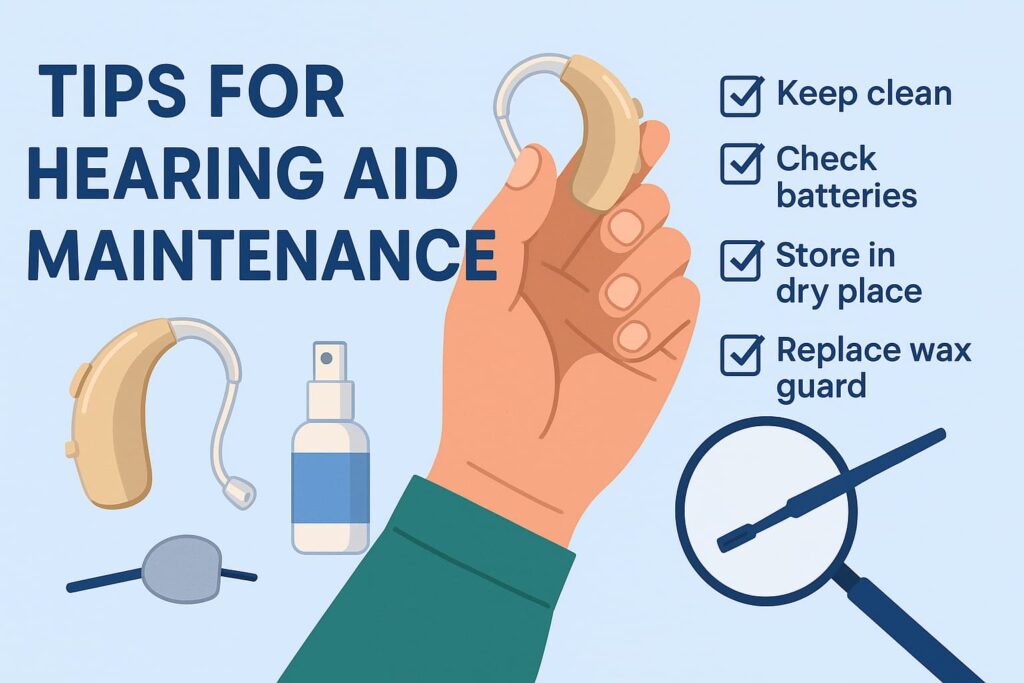
A Professional Guide to Hearing Aid Maintenance will be Available for 2025
The maintenance process for hearing aids directly enhances their operational life while strengthening their performance levels. The essential nature of hearing aid maintenance and cleaning procedures applies to all types including behind-the-ear (BTE), in-the-ear (ITE), and receiver-in-canal (RIC) models because they protect against technical malfunctions and enhance sound output quality.
Here are the essential reasons for hearing aid maintenance
These small electronic devices operate as portable devices which users wear either over or inside the ear. They’re exposed to:
- Earwax buildup
- Moisture and sweat
- Dust and debris
These factors can affect sound clarity or cause malfunctions without regular care. This is why every user needs to know how to care for a hearing aid.
Step-By-Step Hearing Aid Maintenance Tips
Curious on how to take care of your hearing aid? Here’s a simple maintenance checklist:
1. Daily Maintenance
Wipe dry:
Touch: Use hearing aid cleaning wipes to remove any sweat or moisture.
Ensure to wipe all parts:
Senior Healthcare Providers must pay attention to both microphone and receiver along with tubing components to reduce condensation accumulation.
Check for earwax:
Use a gentle cleaner on the microphone and receiver area.
Nightly open battery door (non-rechargeable models) to allow moisture to escape.
2. Weekly Maintenance
- Clean deep with a hearing aid cleaning kit
- Wash earmold and tubing in warm, soapy water (if removable)
- Check for any tears or damage
3. Monthly Maintenance
- Change wax guards and filters.
- It is ideal to replace hearing aid tubes every one to two months when they turn yellow or become hard.
How to Clean a Hearing Aid Properly?
The appropriate cleaning method depends on which hearing device one uses.
|
Hearing Aid Type |
Cleaning Tips |
|---|---|
|
BTE (Behind-the-Ear) |
Take out and clean earmold separately |
|
RIC (Receiver-in-Canal) |
Clean the receiver using a brush that is soft |
|
ITE (In-the-Ear) |
Remove wax build-up with a wax pick for microphone openings |
NEW YORK (AP) — To clean hearing aids, you will need some hearing aid cleaning tools such as brushes, wax picks, vent cleaners, etc.
How often do you clean a hearing aid?
Light cleaning: Daily
Deep cleaning: Weekly
Professional service: Every half a year
The one I use requires changing tubes and wax filters as needed to keep the sound coming through clear.
Cleaning Hearing Aid Receivers and Wax Buildup
Receivers can easily become clogged with earwax. Here’s how to clean them:
- Use a small brush to remove visible wax
- Replace wax filters if needed
- Do not apply water to the electronic components directly
Device specific tips like how to clean the Starkey hearing aids?
Refer to the manufacturer’s guide or watch Starkey hearing aid cleaning videos from Youtube.
Preventive Tips:
Ways You Can Protect Your Hearing
Taking care of hearing aids is just one part of the equation — looking after your hearing is important, too:
- Do not expose yourself to loud sounds; wear ear protection if so
- Keep your ears dry and clean
- Get regular hearing tests
- Products for Cleaning Hearing Aids
- Hearing aid cleaning kits
- Drying boxes
- UV sanitizers
- Cleaning wipes
- Soft brushes and vent picks
You should choose cleansing tools that work with Starkey or Phonak or Signia devices.
What are the basics of hearing aid maintenance and care?
The correct handling of your hearing aids keeps both operational performance and device endurance in optimal conditions. The hearing aid care and maintenance consist of a few basic steps:
1. Clean Your Hearing Aids Regularly:
Why? The combination of dirt with moisture together with wax can cause harm to internal component parts.
How?
- A soft cloth is your tool for wiping down the hearing aid exterior.
- Clean the earmold and microphone openings with a small brush or wax pick.
- Avoid using any harsh chemicals.
- People who need to protect moisture in their environment can use drying kits combined with dehumidifiers particularly when they reside within humid climates.
2. Change the Batteries:
Why? Below-par battery power will diminish sound quality and it might lead to hearing aid shutdown.
How?
- Refueling disposable battery power cells must be done every 5–7 days (based on operational frequency).
- People with rechargeable units should remember to recharge their devices everyday to prevent sudden switching off.
3. Protect from Moisture:
Why? Remote water exposure leads to short circuits as well as harms the device’s internal components.
How?
- Avoid wearing your hearing aids in the rain or during heavy sweating (e.g., exercising).
- Store your hearing aids in a dry box or dehumidifier at night.
- Silica gel packets together with desiccant beads serve as effective moisture-absorbents.
4. Store Them Properly:
Why? Hearing aids maintain protection from dirt as well as damage and moisture through appropriate storage.
How?
- You should keep hearing aids in protective cases when they are not being used.
- The battery lifespan is preserved by disabling the hearing aid before any period of non-use.
5. Check for Wax Build-Up:
Why? A blocking earwax formation reduces sound quality which negatively impacts hearing aid operation.
How?
- Clean the earmold and microphone openings to prevent earwax buildup.
- If necessary, use a wax guard or filter to prevent wax from entering the device.
6. Schedule Regular Check-Ups:
Why? A professional hearing aid maintenance service maintains peak performance of the devices.
How?
You should visit both an audiologist and a hearing aid provider for a complete hearing test while they maintain your devices regularly plus clean your devices twice yearly.
7. Handle with Care:
Why? The device may sustain injury if you drop it or treat it carelessly.
How?
- Caring treatment should always be given to your hearing aids.
- The devices should avoid contact with both intense temperatures and sudden shocks.
8. Use Accessories When Needed:
Why? Both hearing aid dryers and Bluetooth streamers function as accessories which improve the overall usability of hearing devices.
How?
- Use a hearing aid dehumidifier for cleaning and drying.
- Bluetooth streamers serve to improve sound quality when you link hearing aids to phones or TVs through Bluetooth.
Conclusion
Your hearing aids need proper maintenance because proper care will keep them operational. Proper hearing aid maintenance enhances hearing experiences for people who are new to devices and those who have used them for a long time.
Your current hearing devices need attention for maintenance. Contact us now at 01711-636214 or stop by one of our branches around your area.
FAQs
1. What to do if the hearing aid receiver gets dirty?
Gently remove wax with a small brush. For thorough cleaning, make sure to periodically swap out the wax guard.
2. When Should You Change Hearing Aid Tubes?
Once every 1–2 months and/or when they become rigid or their colour shifts.
3. How do you care for a hearing aid?
Daily cleaning, drying out the moisture, proper storage, regular servicing.
4. How to prevent hearing loss?
Minimize noise exposure, clean your ears carefully, and see an audiologist for regular checkups.
5. How do you clean hearing aids of wax?
Use a wax pick or brush. Do NOT use water or sharp objects.
